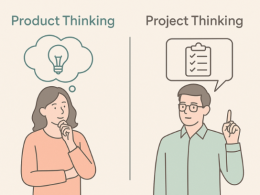In a world where mobile apps have transformed the very fabric of our existence, have you ever wondered how these ingenious creations come to life?
How does an inspired idea evolve into an app that enhances productivity, entertains, or connects us with the world?
And most importantly, what’s the secret behind a mobile app’s successful launch in the fiercely competitive digital landscape?
Creating a mobile app that captures the hearts and screens of users is no simple feat. It’s a journey marked by countless questions and challenges.
How do you identify a market need?
What’s the blueprint for turning your vision into a functional app?
How do you ensure your creation stands out in the crowded app stores?
In this blog, we’re embarking on a thrilling adventure, unraveling the mysteries of the mobile app product lifecycle. We’ll navigate through the fascinating process of bringing your app idea to life and paving the way for a triumphant launch.
So, fasten your seatbelts, because we’re about to embark on a journey filled with discovery and innovation.
Chapter 1: Conception and Ideation
In the enchanting realm of mobile app development, every journey begins with a single spark—an idea. Yet, not all ideas are created equal, and to embark on a path towards app creation, one must venture beyond inspiration and into the realm of understanding market demand.
The heartbeat of a successful mobile app is its ability to address a real problem or fulfill a genuine need. But how does one discern these digital desiderata in the ever-evolving landscape of app users’ desires and aspirations?
The Essence of Market Research
In the quest to create a mobile app that resonates with users, market research is the compass that guides your way. It’s the art of deeply diving into the ever-shifting currents of consumer preferences and industry trends. By understanding the market, you can navigate your app idea toward a haven of relevance and utility.
Why is Market Research Crucial?
- Identifying Pain Points: Market research unveils the pain points and challenges that users face. These are the very catalysts for app creation.
- Competitive Awareness: By studying competitors, you can determine what’s already in the market and, more importantly, what’s missing.
- Market Trends: Market research unveils the prevailing trends, enabling you to adapt and evolve your app concept to align with the zeitgeist.
Competitive Analysis: Learning from the Masters
As you delve into the world of market research, a crucial facet is competitive analysis. This is the art of observing and learning from the successes and shortcomings of existing apps in your chosen domain.
What Can Competitive Analysis Teach You?
- Feature Gaps: Discover what features or functionalities are lacking in competitors’ apps, giving you an opportunity to stand out.
- User Feedback: Analyze user reviews and feedback to uncover what users love and what frustrates them in existing apps.
- Pricing Strategies: Study how competitors monetize their apps—whether through one-time purchases, subscriptions, or ads.
Chapter 2: Planning and Strategy
The voyage of bringing your mobile app to life goes far beyond just creating a digital marvel. It requires a strong foundation built on clear objectives, strategies, and a vision of long-term sustainability. We will navigate the intricate waters of planning and strategy, beginning with the creation of a robust business plan.
A business plan is a compass that steers your app’s course toward success. It is the comprehensive blueprint that outlines your app’s purpose, goals, and the means to achieve them.
Key Components of a Business Plan
- Defining the Purpose: Start by crystallizing the primary purpose of your app. What problem does it solve? What value does it offer to users?
- Revenue Model: Clearly define how your app will generate income. Will it be through app purchases, subscriptions, in-app ads, or a combination of these?
- Pricing Strategy: Decide on the pricing structure that aligns with your target audience and app’s value proposition.
- Monetization Methods: Explore various methods for monetizing your app, such as in-app purchases, freemium models, or affiliate marketing.
- Budget and Financial Projections: Calculate the expenses involved in app development, marketing, and maintenance, and project your revenue to ensure sustainability.
Creating a Roadmap
With a robust business plan as your compass, it’s time to plot a clear roadmap for your app’s development. This roadmap will serve as your guide throughout the journey, ensuring that your app reaches its destination successfully.
Key Elements of a Roadmap
- Feature Set: Define the features and functionalities that your app will include. Start with a minimal viable product (MVP) and plan additional features for future updates.
- Development Phases: Divide the development process into clear phases, each with specific objectives and timelines. This helps in managing the project efficiently.
- Timelines and Milestones: Set realistic timelines for each phase and establish milestones to track progress.
- Resource Allocation: Identify the required resources, including human resources, technology, and budget, for each phase.
- Quality Assurance and Testing: Incorporate quality assurance and testing phases into the roadmap to ensure a bug-free launch.
Why a Roadmap Matters
A roadmap provides a structured approach to app development, reducing the risk of scope creep and delays. It ensures that all team members, stakeholders, and partners are aligned on the app’s development path, making the journey more predictable and manageable.
Chapter 3: Development and Design
As you embark on the exciting journey of bringing your app to life, one of the pivotal decisions you’ll face is choosing the right development approach. The choice between native, hybrid, or cross-platform development is a crucial step that significantly impacts your app’s performance and user experience.
Understanding the Development Approaches
- Native Development: Native apps are tailored for a specific platform (e.g., iOS or Android) and are built using platform-specific programming languages and tools (Swift/Obj-C for iOS, Java/Kotlin for Android). They offer the best performance and access to platform-specific features but require separate development for each platform.
- Hybrid Development: Hybrid apps are developed using web technologies like HTML, CSS, and JavaScript. They run within a native container that provides access to device features. While hybrid development can save time and resources, it may have limitations in terms of performance and access to certain native features.
- Cross-Platform Development: Cross-platform development allows you to write code once and deploy it on multiple platforms. Frameworks like React Native, Flutter, and Xamarin have gained popularity for cross-platform app development. They strike a balance between code reusability and native-like performance.
Making an Informed Decision
The choice of development approach should align with your app’s goals, target audience, and available resources.
Here are some factors to consider:
- Budget: Native development can be more costly due to separate development for each platform. Cross-platform development is often more cost-effective.
- Performance: Native apps generally offer the best performance and access to platform-specific features. However, cross-platform development is catching up in terms of performance.
- Time to Market: Hybrid and cross-platform development can expedite the development process, making it quicker to launch your app.
- User Experience: User experience is paramount. Ensure your chosen development approach allows you to create an app with an intuitive, responsive, and user-friendly interface.
User-Centered Design: Shaping the App’s Soul
Design is not just about aesthetics; it’s about crafting an experience that resonates with users and keeps them engaged. User-centered design is the art of creating an intuitive and enjoyable user interface (UI) and user experience (UX) that align with your app’s purpose.
Key Aspects of User-Centered Design
- User Research: Begin with user research to understand your target audience’s needs, preferences, and pain points.
- Prototyping: Create prototypes to visualize the app’s layout and functionality. This helps in early testing and refinement.
- Iterative Design: Embrace an iterative design process, continually improving your app based on user feedback and testing.
- Consistency and Simplicity: Maintain consistency in design elements, such as colors, fonts, and navigation. Keep the design simple and easy to understand.
- Accessibility: Ensure that your app is accessible to users with disabilities, following accessibility guidelines.
- Testing and Feedback: Continuously test your app with real users to gather feedback and make improvements.
User-centered design is not just a visual element; it’s a strategic approach that enhances user satisfaction, engagement, and retention. It ensures that your app resonates with your audience, leading to positive reviews and word-of-mouth recommendations.
Chapter 4: Testing and Quality Assurance
As you journey towards the launch of your mobile app, it’s crucial to embark on a rigorous testing and quality assurance phase. This phase is the crucible where your app’s robustness and user-friendliness are put to the test.
The Importance of Comprehensive Testing
- Usability Testing: Invite real users to interact with your app, identifying any difficulties or pain points in navigating and using the app.
- Functional Testing: Scrutinize your app’s features and functionalities, ensuring that they work as intended. This includes examining all interactive elements, such as buttons, forms, and menus.
- Performance Testing: Evaluate your app’s performance under various conditions, such as different devices, network speeds, and user loads.
- Bug and Glitch Detection: Identify and rectify any bugs, glitches, or errors that may disrupt the app’s functionality.
User Feedback Integration: The Power of Iteration
User feedback is an invaluable compass guiding your app towards excellence. Encourage beta testing and gather user feedback to fine-tune your app’s performance and enhance user satisfaction.
Why User Feedback Matters
- Real-World Insights: User feedback provides real-world insights into how users engage with your app and what issues they encounter.
- Continuous Improvement: Use feedback to make necessary improvements, ensuring that your app aligns with user expectations.
- Positive User Experience: Responsive action to user feedback cultivates a positive user experience, fostering user loyalty and positive reviews.
Chapter 5: Preparing for Launch
Marketing and Promotion: Igniting the App’s Journey
Before your app sets sail into the app stores, prepare a robust marketing and promotion strategy. This will ensure that your app doesn’t get lost in the vast digital ocean.
The Elements of a Marketing Strategy
- Social Media: Leverage social media platforms to create a buzz around your app. Engage with potential users and build a community.
- App Store Optimization (ASO): Optimize your app’s store listing with relevant keywords, captivating visuals, and compelling descriptions to maximize visibility.
- Content Marketing: Craft engaging content, such as blog posts, videos, or infographics, to showcase the app’s features and benefits.
App Store Submission: Navigating the Submission Process
As your app nears readiness, it’s time to submit it to major app stores. Follow the guidelines of platforms like the Apple App Store and Google Play Store for a smooth submission process. Ensure that your app meets their standards to ensure a successful launch.
Chapter 6: Post-Launch and Growth
After your app sets sail, the journey doesn’t end; it evolves. Continuously monitor its performance using analytics tools, tracking key performance indicators (KPIs) and user behavior to make data-driven decisions.
Key Metrics to Monitor
- User Engagement: Measure user activity within your app, tracking metrics like user sessions, retention rates, and time spent.
- Conversion Rates: Analyze how many users take desired actions, such as making in-app purchases or subscribing to services.
- App Crashes: Keep an eye on app stability, monitoring for crashes or technical issues.
Sustaining your app’s growth and success hinges on keeping users engaged and content. Regular updates, feature enhancements, and responsiveness to user feedback are crucial. Building a community around your app fosters long-term success.
Bringing a mobile app from idea to launch is a complex and multifaceted journey. Each phase of the mobile app product lifecycle requires careful planning and execution.
By understanding the nuances of this lifecycle, you can increase your chances of creating a successful mobile app that resonates with users, adds value, and contributes to your business goals.
The mobile app ecosystem is competitive, but with a strategic approach and a commitment to quality, you can navigate the path to a successful app launch.
 Pin
PinReady to elevate your product management skills to the next level? Join Accredian’s Executive Program in Product Management today!






